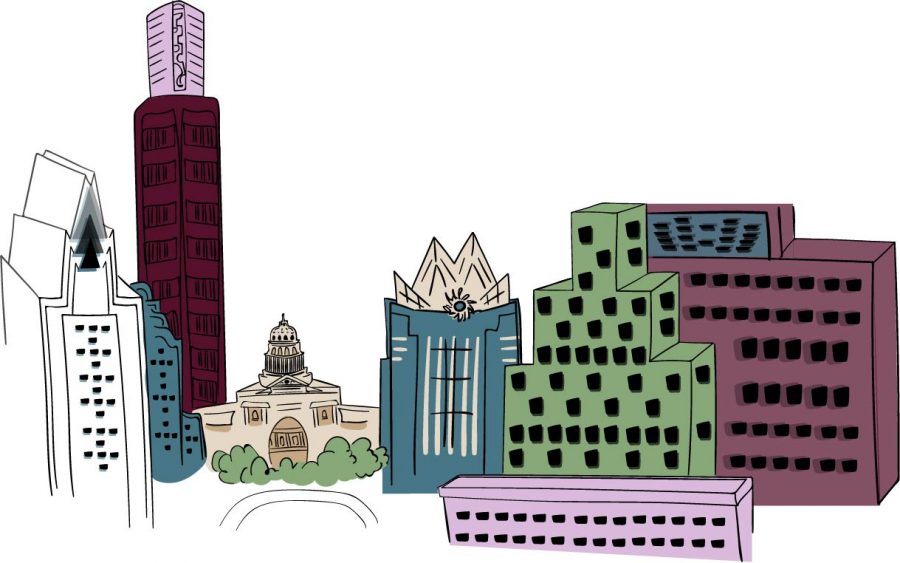Austin Faces Rising Rates of Urban Homelessness
October 9, 2019
Homelessness is on the rise in America. In Austin, there are over 2000 homeless people in need. Many of the homeless resort to living on the street or living in temporary housing provided by charitable organizations. The Austin Resource Center for the Homeless (ARCH), which is run by Front Steps Organization, is on the front lines of assisting the itinerant population in the city.
Front Steps is an Austin based organization that helps the homeless find safe and affordable housing. They feed and house around 100 homeless every night at the ARCH and provide services to over 150 people during the day. The organization’s scope of involvement is limited by its infrastructure which does not have enough capacity to serve all of the people in need each day. Amy Price is the Communications and Development Director at Front Steps.
“Front Steps is a nonprofit that helps provide safe, secure housing,” Price said. “We help people get things organized so that they can get housing or pay off bills, or get an I.D. so that they can get a job.”
According to Price, the most direct cause of homelessness is that wages are not keeping up with the cost of living in Austin. Price said that while some of Front Step’s money comes from donations, the majority of their funding and support comes from the city of Austin. According to KUT, Austin has $62 million set aside for helping the homeless population.
“We operate ARCH, but the city of Austin owns the building,” Price said. “They provide funding based on how many people we serve.”
The Ending Community Homelessness Coalition, or ECHO, completed a survey in March of 2019 to inform the city of the current homeless situation. The study showed that since 2015, the number of homeless people on the street has steadily increased, jumping from 1,832 homeless in 2015 to 2,255 homeless in 2019.
“They weren’t born homeless,” Price said. “Something happened that knocked them off of the path [they] expect to be on.”
Religious organizations all around Austin are also doing their part to help the homeless. Vicki Matustik, the Director of Connections and Services at Oak Hill United Methodist Church, said that one of the most impactful programs that Oak Hill UMC runs is their freeze shelters, which provide warm housing on cold winter nights.
“[The homeless are] welcome to sleep [at the church] and have a hot dinner…we also let them take a hot shower and change into dry clothes,” Matustik said.
Oak Hill UMC works with other churches around Austin to provide more long term shelter to the homeless as well. In these shelters, guests have access to a shower, bathroom, enough food for three meals a day and clean water. However, this is not always available to everyone in the homeless population. According to the ECHO survey, 51 percent of the homeless population does not have constant access to these necessities.
“They would move everything they owned into our church… at the end of the week, they would go spend the day at the Interface Hospitality Network and then move into another church,” Matustik said.
The shelters give the guests basic necessities, in addition to a chance to connect with other people. Matustik and the other volunteers who worked with the IHN found a connection between themselves and the homeless guests.
“We found ourselves thinking, ‘We’re the caregivers, they’re the recipients,’ but every night, we found that instead of it being us and them, it felt like a community,” Matustik said.
While these temporary houses can offer interpersonal connections and basic necessities, long term housing is much more difficult to secure. Due to the lack of affordable housing in Austin, not all homeless families can get into a permanent shelter after their first time through the program. Affordable housing has become a growing problem in Austin as the population continues to grow.
“They could be in the program for 12 weeks,” Matustik said. “Sometimes families come through more than once because it didn’t work out.”
The shelter often faces difficulties in finding enough volunteers to staff and run the shelter. Matusik said the connections and relationships homeless people make with shelter staff and volunteers can be as important to their well being as the basic necessities the shelter supplies.
“People are afraid of what they don’t know,” Matustik said. “Getting people to take the first step is the biggest challenge. Once they’re in, they’re in. I’ve learned from working with people that what homeless people miss or need more than anything isn’t shelter or food, but just to be acknowledged as a person. If you watch people on the corner asking for money, most people are uncomfortable and won’t even make eye contact. Homeless people will tell me that makes them feel like they don’t even exist.”
Many students have found ways to get involved and help the cause. Junior Daniel Resendiz has volunteered to help the homeless with his scout troop.
“We gave them soup and gave them bags filled with basic necessities,” Resendiz said. “It’s rewarding because they don’t have support from anyone, and when you help them, you get to bring them joy.”
Price stressed how important it is for citizens to recognize the homeless population and to get involved in any way they can. Most organizations that help the homeless rely on volunteers, and without them, these organizations would be inoperable.
“I think it’s really important to help people understand how easy it is to help people,” Price said. “They are not horrible people. They have stories too.”
Matusik has learned that the best way to help the homeless is to treat them as equals.
“Start seeing the things you have in common with them instead of the things that are different,” Matusik said. “That begins to break down the walls.”


